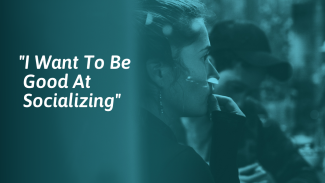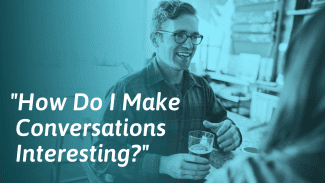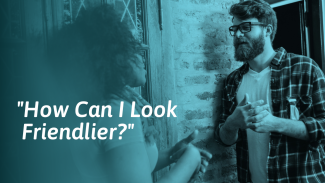“I don’t know how to be friendly, especially to people I’ve only just met. I want to know how to be a friendly person who comes across as warm and likable.”
I used to have no clue how to be friendly toward people.
After studying social skills and behavioral science for years, I’ve helped thousands of people become more sociable and friendly.
Sections:
How to Be More Friendly
1. Smile more
Give people a sincere smile when you greet them and say goodbye. Avoid having a constant smile on your face, though – that can make you come off as nervous.[1]
2. Ask sincere questions
Show that you are interested in others by asking them a few sincere questions. This signals that you care about them and want to get to know them.
The other day someone asked me, “Running a blog like you do sounds so exciting! Would you recommend that way of making a living?” It made that person come off as super friendly.
3. Remember and use people’s names
When someone tells you their name, create a mental association that will help you remember it. For example, if someone’s named Steve, you can imagine him hugging Steve Jobs.
Use their name whenever it makes sense. For example, “It was really nice meeting you, Steve.”
This signals that you care about them, and they’ll see you as a friendly person.
4. Relax your face
When we feel nervous, our faces tense up, and we can look angry, reserved, or inhibited. Practice relaxing your facial muscles and let your sincere facial expressions shine through.
Think about how you react with people you are comfortable around. You want to react in the same way around new people.
5. Take the initiative to talk to people
Starting a conversation makes it clear that you’re friendly and open to interaction.
Make a simple statement about the situation to signal that you want to talk, e.g., “That salmon looks good,” “Were you also up late preparing for the test?” or, “Where did you find that Snapple?”
Read our separate guide on how to start a conversation.
6. Acknowledge people you know
Nod, smile, or say hi to people when you see them. It might feel easier to ignore them, but if you do, it can look like you don’t like them.
7. Use open body language
Have your arms along your sides instead of crossing them. Avoid looking down. Open body language signals friendliness and makes you look more approachable. If you tend to slouch, try to improve your posture — you’ll appear more confident. Watch this video on fixing a hunchback posture for tips.
8. Make eye contact
Look people in the eyes whenever you greet them, listen, or talk.[5]
If eye contact makes you uncomfortable, try to figure out the color of the other person’s iris. Another trick is to look at their eyebrows instead. See this guide to confident eye contact for more advice.
9. Avoid giving “Yes” or “No” answers
If someone asks you, “How was your weekend?” don’t just say “Good.” That gives the impression that you don’t want to talk.
Give some extra information and ask a question of your own. For example, “It was good. I took a walk in the forest behind my house and finished reading a novel. How was yours?”
10. Take time to talk to people you already know
Start talking to people you know, even if you don’t have something important to tell them.
Simple conversation is a signal that you want to interact. It can be as easy as saying, “Hi Liza, how was your weekend?” Be prepared to answer follow-up questions they are likely to ask you. In this case, Liza would probably want to know what you did at the weekend too.
11. Invite people to events
Make a habit of inviting people along to social gatherings. (Make sure everyone’s fine with you bringing an extra person along.) Whenever you go to an after-work gathering, a workshop, or an event, ask yourself, “Is there someone else who might want to join me?”
12. Make everyone feel included in conversations
If you are in a group and someone is awkwardly on the edge of a conversation, include them by asking a question. Engage them by making eye contact, smiling, and using their name.
For example, let’s say you are in a group conversation, and everyone is talking about how they would love to try scuba diving. Your friend Amira, who can be shy, is there. She has been diving several times. To help her feel part of the conversation, you could say, “Amira, I know you’ve done some scuba diving. What’s it like?”
If someone is interrupted, help them out by bringing the attention back to them. This is a thoughtful gesture that shows you are interested in what they have to say.
For example:
Shadia: One time when I was in Paris…
Someone: Interrupts
You, a bit later: Shadia, what were you going to say about Paris?
13. Give sincere compliments
When you think someone did something or said something good, let them know about it.
For example:
- “Maria, I liked what you said earlier about electric cars.”
- “I’m so impressed that you were able to paint the entire house in just two days.”
- “You’re such a good writer!”
When you say something nice about what someone DID, they will feel that you like THEM. Avoid compliments about their personal appearance because this can come across as inappropriate.
14. Remember small things about people
If someone says that they’re going to start a new job, go on a vacation, buy a new car, or renovate their home, follow up on that and ask them about it. It shows that you care and that you’re friendly.
For example:
- “How’s the new job?”
- “How was the vacation?”
- “How’s the new car?”
- “How’s the renovation going?”
Only bring something up if it’s something both of you will probably remember. Avoid bringing up negative memories.
15. Show that you listen
Don’t just listen. SHOW that you listen. It makes it rewarding and fun to be with you.
- Say “Hmm,” “Oh,” and “Yeah” when appropriate.
- Nod and make authentic reactions with your face.
- If you zone out, bring your focus back to the conversation. It’s easier to stay in the moment if you cultivate a sincere interest in what the other person is saying.
- Rather than thinking about what you should say next, be curious about what they tell you and ask follow-up questions.
16. Show that you listen in group conversations
It’s easy to zone out in group conversation if we don’t feel involved. Listen actively as I explained in the previous step. You will notice that whoever is speaking will start talking to you more because you reward them with your attention.
17. Avoid looking at your phone
When someone’s talking, never look at your phone. If you HAVE to look at your phone (because bad things will happen if you don’t), explain why. For example, “I’m really sorry to interrupt you, but my friend is locked out outside my house right now, and I need to explain where the key is.”
If you don’t put your phone away, people will think that you don’t care about them.
18. Help people out
Kind acts signal that you are friendly.[4] Help people with things that are easy for you but hard for them.
For example, help someone who struggles with math to solve an equation because you’re good at it, but don’t offer to travel 5 miles to help replant someone’s cactus.
There’s an exception: Don’t help people who never give anything in return.
19. Count to 3 before you criticize or condemn
Only criticize someone or something when it really matters. Even if you aren’t condemning the person you’re talking to, speaking badly of someone can make you come across as unfriendly. Everyone around you might think, “If this person criticizes people behind their backs, what will they say about me when I’m not around?”
20. Be generally positive
Make a habit of being positive. Remember:
- Make positive statements when something is good. Praise and express your appreciation to people when they do things well, and if you’re enjoying yourself, let everyone know.
- Don’t say negative things out of habit. When you catch yourself making deprecating remarks, stop and make a positive remark instead.
- When you need to talk about a problem or make a complaint, offer a solution.
It’s OK to be negative at times, and being OVERLY positive can look fake. But be positive in general.
21. Be in tune with people’s emotions
Being friendly isn’t just about being positive all the time. It’s also about making a friend understand that when they tell you their problems, you feel their pain.
If someone’s having a hard time, don’t try to solve their problem or be overly positive. Just be a good listener and acknowledge that they are struggling. It can help to repeat what they say using your own words to make it clear that you’ve understood. For example, “It sounds like these exams are really stressing you out.”
22. Avoid disagreeing for the sake of it
People who can see others’ perspectives easily and don’t have an urge to argue have more friends.[2] Don’t argue for the sake of arguing. Be agreeable when discussing things that aren’t that important.
For example, don’t do this:
Someone: I love trance.
You: Seriously? It all sounds the same.
However, when something does matter, stand up for your beliefs.
23. Look at naturally friendly people and learn from them
Do you know someone who comes across as warm and likable? Analyze what they do. Let them be your role models that show you how to be more friendly.
- What do they say?
- How do they say it?
- What do you never hear them saying?
- How do they handle negative people?
Look for clues as to why they are seen as friendly and learn from them. When you feel awkward in a social situation, ask yourself, “What would my role model do?”
24. Use mirroring to create rapport
Research shows that if you subtly mimic someone’s body language, they will be more inclined to like you.[6]
For example, if the person you are talking to puts their hands in their lap, try waiting a few seconds before slowly moving your hands into a similar position. Do not overdo it, or you’ll come across as creepy.
To test whether you have established rapport, change your body position. If the other person mirrors you within 30 seconds, they probably feel in sync with you.[7]
25. Show gratitude
According to one study, showing gratitude towards others makes you appear friendly and thoughtful.[8] When someone does you a favor, don’t just mumble “Thanks.” Smile, make eye contact, and say, “Thank you!”
26. Use social touch
Social touching increases likability[9] and can make you seem friendlier. Lightly touch someone on the arm, between their elbow and shoulder, when you want to make a point or express empathy. If you are both sitting down, gently touch their knee.
27. Welcome new people
For example, when a new coworker joins your company, you could:
- Offer to show them around
- Introduce them to your other coworkers
- Invite them along to social events outside of working hours
- Fill them in on the latest news and give them a background on the politics of the office
If someone new moves in next door, stop by and welcome them to the neighborhood. If your friend brings their new boyfriend or girlfriend along to an event, make time to chat with them.
28. Use positive humor
Making jokes or appreciating the funny side of a situation can help you come across as a friendly person. Avoid heavy sarcasm, mockery, or making jokes at someone else’s expense. Instead, focus on light-hearted observations about everyday life.
It’s OK to gently poke fun at yourself, but it’s best to avoid self-deprecating humor because it can make others feel uncomfortable.
29. Lift others up
Be a positive gossip. Instead of speaking badly of people behind their backs, say nice things about them when they aren’t around. This will make you come across as friendly and trustworthy.
You can also pass on compliments you’ve heard from someone else by weaving them into a conversation.
For example:
“Hey Joe, Lousie was telling me the other day that you’re an awesome baker. I made bread at the weekend, but it just wouldn’t rise! Do you have any tips?”
How to be Confident and Relaxed Enough to be Friendly
It can be hard to be friendly if you feel nervous or shy. Perhaps you feel like people won’t like you when you walk up to them and that you’ll be rejected. Or, maybe you just don’t know what to say.
Here’s some advice on how to dare to be friendly.
1. Change the way you talk to yourself
If you feel that others will judge you, it could be that you judge yourself. Perhaps you have a negative voice in your head that complains all the time. Then it’s easy to believe that others will think those same things about you.
Talk to yourself like you would talk to a friend you like and respect.
If your voice says, “people hate me,” think back to other times that might prove the voice wrong. Perhaps you can remember a time where people really seemed to like you. That may prove that people don’t hate you.[3]
2. See rejection as a good thing
It can be scary to take the initiative, invite people, approach them, or be friendly first because we might get rejected.
See rejection as a good thing: it proves that you tried. If you don’t get rejected, it means that you haven’t taken any chances.
3. Say yes to invitations
If you say “No thanks” whenever people ask you to hang out, eventually they will stop inviting you. You’ll lose valuable opportunities to practice your social skills, and you’ll become more isolated.
Make it a habit to say yes to invitations even if you don’t feel like it in the moment. You don’t have to stay for the whole event. For example, if you are invited to a party, you could set yourself a goal of staying for an hour.
Read more: How to become more social.
4. Dare to be friendly first
Don’t wait for people to be friendly before you dare to be friendly back. They feel the same uncertainty and might also be waiting! If you act hesitant, they’ll act hesitant too.
Greet people with a warm smile and ask a sincere question about what they do or what they are up to. That’s when they dare to be friendly back. If you don’t get a positive response, remember that it isn’t necessarily personal. Everyone has bad days.
5. Read books on social skills
Read up on social skills to be more comfortable in social settings. Here’s our guide on the best books on social skills.












Thank you for putting such beautiful and informative piece together.
I was glued to this page for hours, I feel like I just finished a Harvard program.
Thank you